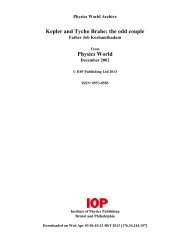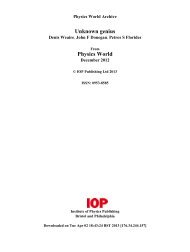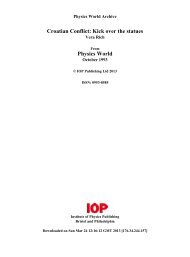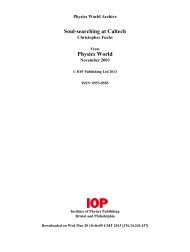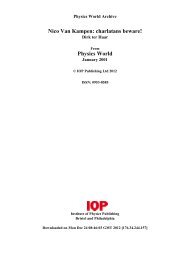Hans Kramers: a master thinker Physics World - Institute of Physics
Hans Kramers: a master thinker Physics World - Institute of Physics
Hans Kramers: a master thinker Physics World - Institute of Physics
Create successful ePaper yourself
Turn your PDF publications into a flip-book with our unique Google optimized e-Paper software.
<strong>Physics</strong> <strong>World</strong> Archive<br />
<strong>Hans</strong> <strong>Kramers</strong>: a <strong>master</strong> <strong>thinker</strong><br />
<strong>Hans</strong> van Leeuwen<br />
From<br />
<strong>Physics</strong> <strong>World</strong><br />
August 1998<br />
© IOP Publishing Ltd 2012<br />
ISSN: 0953-8585<br />
<strong>Institute</strong> <strong>of</strong> <strong>Physics</strong> Publishing<br />
Bristol and Philadelphia<br />
Downloaded on Mon Dec 24 09:12:39 GMT 2012 [176.34.244.157]
REVIEWS<br />
Han* vdii<br />
<strong>Hans</strong> <strong>Kramers</strong>: a <strong>master</strong> <strong>thinker</strong><br />
Master <strong>of</strong> Modern <strong>Physics</strong>: The Scientific<br />
Contributions <strong>of</strong> H A <strong>Kramers</strong><br />
1998 Princeton University Press 296pp<br />
£27.50/$39.50hb<br />
With the approach <strong>of</strong> the new millennium,<br />
the physics community is more than usually<br />
inclined to look back in amazement at the<br />
marvellous developments in physics during<br />
the first half <strong>of</strong> this century. Unfortunately,<br />
the heroes <strong>of</strong> that great period did not really<br />
bother to record the history <strong>of</strong> their painful<br />
struggle to come to terms with new realities<br />
such as relativity and quantum physics.<br />
However, the next generation <strong>of</strong> physicists,<br />
who were still able to witness the giants, were<br />
more reliable at keeping historical records.<br />
Thanks to their efforts, we now have a<br />
host <strong>of</strong> (auto)biographies about such scientists,<br />
which explain the ins and outs <strong>of</strong> the<br />
personal relationships and the atmosphere<br />
in which the research took place. Aimed at<br />
the general public, the scientific content <strong>of</strong><br />
these books is, however, usually restricted to<br />
a few elementary formulae. Not so in this<br />
new book by Dirk ter Haar on the scientific<br />
achievements <strong>of</strong> the great Dutch physicist<br />
Hendrik <strong>Kramers</strong>.<br />
<strong>Kramers</strong>, who was known to his friends as<br />
<strong>Hans</strong>, is a most intriguing personality—both<br />
for his contributions to physics and for his<br />
style and character. He began his career in<br />
1916 as a student <strong>of</strong> Niels Bohr, and pretty<br />
soon he became his main assistant. He<br />
stayed at Bohr's institute in Copenhagen<br />
until 1926, when he went back to the<br />
Netherlands to become a pr<strong>of</strong>essor, first in<br />
Utrecht and later in Leiden, where he<br />
remained until his death in 1952, aged 57.<br />
In 1987 the late Max Dresden wrote an<br />
extensive biography <strong>of</strong> <strong>Kramers</strong>, which<br />
includes an exciting record <strong>of</strong> the development<br />
<strong>of</strong> the old quantum theory to its<br />
Dutch <strong>master</strong> - <strong>Kramers</strong> shone throughout physics<br />
chosen 12 <strong>of</strong> <strong>Kramers</strong>' papers, all <strong>of</strong> which<br />
appear here translated into English. The<br />
author comments on each paper in detail,<br />
before putting them in the context <strong>of</strong><br />
<strong>Kramers</strong>' overall work. The choice <strong>of</strong><br />
papers was difficult - and personal, as the<br />
author admits. For example, he has included<br />
a short paper on band structure at the instigation<br />
<strong>of</strong> another Dutch physicist, Hendrik<br />
Casimir. While it does not contain any<br />
particularly important results, it reveals<br />
the characteristic elegance <strong>of</strong> so much <strong>of</strong><br />
<strong>Kramers</strong>' work.<br />
Naturally, <strong>Kramers</strong>' papers from 1924 on<br />
dispersion relations get ample attention, as<br />
they were central to his pre-occupation with<br />
the interaction between radiation and<br />
matter. They were the last great step in the<br />
"old" quantum theory, being the immediate<br />
forerunners <strong>of</strong> Heisenberg's formulation <strong>of</strong><br />
matrix mechanics. Unavoidably, the relationship<br />
between dispersion relations and<br />
the paper by Bohr, <strong>Kramers</strong> and Slater<br />
(BKS) on radiation processes is discussed,<br />
present form {HA <strong>Kramers</strong>: Between Traditionwhich<br />
for a while <strong>Kramers</strong> considered to be<br />
and Revolution, Springer, 1987). One mighthis<br />
major achievement.<br />
wonder what motivated ter Haar to devote This ill-fated attempt to create a theory <strong>of</strong><br />
another book to <strong>Kramers</strong> so soon after the interaction <strong>of</strong> radiation and matter in<br />
Dresden's elaborate study. Ter Haar's the context <strong>of</strong> the old quantum theory is<br />
answer is that Dresden pictured <strong>Kramers</strong> now almost forgotten. It abandoned the<br />
as a giant who narrowly missed a number idea that energy and momentum are con-<br />
<strong>of</strong> important discoveries, which portrayed served in every quantum jump and restored<br />
<strong>Kramers</strong> as a somewhat tragic figure. Ter the conservation only on a statistical level.<br />
Haar wants instead to highlight <strong>Kramers</strong>' However, soon after the BKS theory was<br />
great scientific achievements, through introduced, it was refuted by the measure-<br />
which he will be remembered in physics. ments <strong>of</strong> the Compton effect, which showed<br />
So ter Haar does not repeat or quarrel that the conservation laws were indeed<br />
with Dresden, but gives a careful account <strong>of</strong> obeyed in each quantum process.<br />
<strong>Kramers</strong>' ideas, analysing his discoveries Bohr took the setback light-heartedly, but<br />
step by step. Rather than trying to cover for <strong>Kramers</strong> it was a much more serious<br />
every aspect <strong>of</strong> his work, ter Haar has blow. However, history has shown us that<br />
the BKS theory was pivotal in the development<br />
<strong>of</strong> quantum mechanics, in particular<br />
by associating a probability field with quantum<br />
processes. This was a seminal step in<br />
the interpretation <strong>of</strong> the wavefunction, as<br />
shown by the fact that Schrodinger, its<br />
inventor, found it hard to come to terms<br />
with the probabalistic interpretation <strong>of</strong> the<br />
wavefunction. In fact, Max Born, who ultimately<br />
formulated the probability interpretation,<br />
gave much credit to the BKS theory.<br />
Ter Haar also takes great pleasure in<br />
describing <strong>Kramers</strong>' derivation <strong>of</strong> the<br />
Wentzel-<strong>Kramers</strong>-Brillouin (WKB) approximation<br />
to the wavefunction. This<br />
paper typifies the way in which <strong>Kramers</strong><br />
excelled through his unsurpassed knowledge<br />
<strong>of</strong> mathematical physics and the old<br />
quantum theory. Anomer paper, which is<br />
described like a novel by ter Haar, is the<br />
so-called "<strong>Kramers</strong> problem" <strong>of</strong> how a<br />
Brownian particle tunnels through a potential<br />
barrier. Ter Haar goes as far as to say<br />
that reading this paper is like listening to a<br />
Mozart string quartet. This and other<br />
papers on charge conjugation, the <strong>Kramers</strong>'<br />
degeneracy and the introduction <strong>of</strong> the<br />
transfer-matrix method all show the broad<br />
scope <strong>of</strong> <strong>Kramers</strong>' work.<br />
One can forgive anybody who spent 10<br />
years in Copenhagen — as Niels Bohr's first<br />
lieutenant during the crucial time in the<br />
development <strong>of</strong> quantum mechanics - to be<br />
obsessed exclusively with the deeper aspects<br />
<strong>of</strong> physics. But even in his Copenhagen<br />
years, surrounded by the almost oppressive<br />
influence <strong>of</strong> Bohr, <strong>Kramers</strong> found time to<br />
divert his interest to other fields, such as general<br />
relativity and statistical physics.<br />
Famous old papers can be hard to appreciate<br />
in their proper context, and <strong>Kramers</strong>'<br />
are no exception. Indeed, he had such great<br />
powers that his papers need — to use the<br />
words <strong>of</strong> his student Nico van Kampen - a<br />
"careful perusal" to properly digest their<br />
lines <strong>of</strong> argument. Ter Haar's book therefore<br />
comes as a very welcome service to the<br />
physics community.<br />
However, the reader should follow ter<br />
Haar's advice and also consult Dresden's<br />
biography <strong>of</strong> <strong>Kramers</strong>; indeed, the two<br />
books together provide an ideal way <strong>of</strong><br />
understanding <strong>Kramers</strong> and his work.<br />
Whereas Dresden is mainly concerned with<br />
<strong>Kramers</strong>' role in the development <strong>of</strong> quantum<br />
mechanics and quantum field theory,<br />
and in <strong>Kramers</strong> as a person, ter Haar balances<br />
this by highlighting the broad impact<br />
<strong>of</strong> <strong>Kramers</strong> in other areas <strong>of</strong> physics. Ter<br />
Haar's method <strong>of</strong> including a selected set <strong>of</strong><br />
<strong>Kramers</strong>' papers in one half <strong>of</strong> the book<br />
PHYSICS WORLD AUOUST 1998 55
» r it i mm c<br />
and discussing them in the other is a happy<br />
combination that greatly simplifies the study<br />
<strong>of</strong> his work. In doing so, the author not<br />
only straightens the historical record on<br />
<strong>Kramers</strong>, but also highlights his virtuosity at<br />
handling the most subtle problems.<br />
Future generations <strong>of</strong> physicists and his-<br />
torians will therefore benefit greatly from<br />
this "careful perusal" <strong>of</strong> the scientific contributions<br />
<strong>of</strong> <strong>Kramers</strong> - probably more so<br />
than the personal tales <strong>of</strong> this century's<br />
other giants <strong>of</strong> physics. The ability <strong>of</strong> ter<br />
Haar to explain and comment on the papers<br />
physics is truly admirable. It makes him,<br />
without doubt, a true student <strong>of</strong> this great<br />
<strong>master</strong> <strong>of</strong> modern physics.<br />
<strong>Hans</strong> van Leeuwe, is an emeritus pr<strong>of</strong>essor <strong>of</strong><br />
physics at the Instituut-Lorentz, Leiden University,<br />
<strong>of</strong> <strong>Kramers</strong> across such a broad spectrum <strong>of</strong> the Netherlands<br />
Philip Anderson<br />
Panoramic view picks out physics<br />
Tlie Ascent <strong>of</strong> Science<br />
1998 Oxford University Press 552pp<br />
£25.00/$35.00hb<br />
Brian Silver's book is an enormously ambitious<br />
project, and might well be subtitled<br />
"Everything you always wanted to know<br />
about science". Silver proposes to explain to<br />
an idealized layreader (whom he calls<br />
"HMS" for "l'homme moyen sensuel") the<br />
"great breakthroughs <strong>of</strong> science" achieved<br />
in the "major battles". He does indeed<br />
demonstrate that he is a fine writer and a<br />
very knowledgeable scientist.<br />
Silver's method is basically historical, so<br />
that the reader acquires a lot <strong>of</strong> insight into<br />
the process <strong>of</strong> science and the philosophical<br />
attitudes from which modern science arose.<br />
He emphasizes again and again the remarkable<br />
inertia <strong>of</strong> the scientific establishment in<br />
the face <strong>of</strong> new ideas. He does so by telling<br />
stories, which, as he points out, make a second<br />
point - that the correct idea eventually<br />
won through, <strong>of</strong>ten against the odds. In this,<br />
as elsewhere, he follows the ideas <strong>of</strong> the<br />
philosopher Karl Popper.<br />
The Ascent <strong>of</strong> Science would seem to be recognizably<br />
a physicists' book. Almost my<br />
first thought on reading it was "What a wonderful<br />
text for a physics course for nonmajors"<br />
- what is <strong>of</strong>ten called "physics for<br />
poets". Silver, in fact, makes a serious<br />
attempt to bring HMS through the kinetic<br />
theory <strong>of</strong> gases, Newton's laws, entropy, elementary<br />
thermodynamics, the concept <strong>of</strong> a<br />
field, the basic laws <strong>of</strong> electromagnetism,<br />
chaos and - finally - quantum mechanics,<br />
the theory <strong>of</strong> the atom and the Standard<br />
Model <strong>of</strong> particle physics. All this is topped<br />
<strong>of</strong>f with a dash <strong>of</strong> astrophysics, relativistic<br />
cosmology, and even inflation.<br />
There is, however, comparatively little<br />
coverage <strong>of</strong> the historical sciences, such as<br />
geology, palaeontology, linguistics, archaeology<br />
and anthropology, even though there<br />
have surely been "great breakthroughs" and<br />
"major battles" in these fields. Of the 552<br />
pages, a few more than 100 are devoted to<br />
biology, 40-50 to chemistry, 20 to applied<br />
science, while true astronomy (as opposed to<br />
cosmology) is covered in 10. The author<br />
takes, one feels, the physicists' somewhat<br />
arrogant view that all other sciences are ba-<br />
Field trip - this journey through science for the layreader focuses on physics<br />
sically applied physics. In the end he seems to<br />
take the extreme reductionist position, emphasizing<br />
Steven Weinberg's "little white<br />
arrows" that lead everything back to the presumably<br />
fundamental laws <strong>of</strong> physics.<br />
Clearly, as he covers all <strong>of</strong> physics in about<br />
300 pages <strong>of</strong> small, dense print, the book is<br />
quite a heavy read — even for one who can<br />
be presumed to be familiar with most <strong>of</strong> the<br />
contents. I have no experience to tell me<br />
how much the layreader (HMS) can absorb,<br />
although he is probably given a much better<br />
chance than by books such as Stephen<br />
Hawking's A Brief History Of Time, Weinberg's<br />
Dreams <strong>of</strong> a Final Theory or Murray<br />
Gell-Mann's The Quark and the Jaguar.<br />
However, one particular — and hopefully<br />
intelligent - layreader who I used as a testbed<br />
balked. Nonetheless, for the rather large<br />
scientifically literate (or even semi-literate)<br />
public, this book is a wonderful refresher<br />
course; it is full <strong>of</strong> unexpected bits <strong>of</strong> history<br />
and is remarkably readable. I, for instance,<br />
was intrigued to discover who Carl Linnaeus<br />
was and how he arrived at his classification<br />
scheme for biological species.<br />
The only real error I noted was on page<br />
199 in the discussion <strong>of</strong> black-body radiation.<br />
"If the temperature goes up," says<br />
Silver, "...the light at the lowest frequencies<br />
will decrease in intensity...". This is illustrated<br />
by figure 15-8a, in which the distribution<br />
is normalized to fit on the same scale<br />
for different temperatures. Of course, the<br />
opposite is true: the light increases in intensity<br />
at the lowest frequencies.<br />
There are a few conversations I would like<br />
to have had with the author, who unfortunately<br />
died shortly before the book was published.<br />
First, need the 21 st-century reader be<br />
bewildered by dogmatic 19th-century statements<br />
such as "the entropy <strong>of</strong> the universe is<br />
increasing", when it will later become clear<br />
that in an expanding, quantum universe this<br />
is a meaningless claim? Secondly, and letting<br />
myself in for more controversy, should not<br />
readers be told - now that decoherence has<br />
become an experimental fact - that the<br />
Copenhagen interpretation <strong>of</strong> quantum<br />
mechanics and mysterious statements like<br />
Feynman's facetious "Nobody understands<br />
quantum mechanics" do not belong in the<br />
21st century either? These ideas were a<br />
crutch suitable for the first half <strong>of</strong> the 20th<br />
century, which we were able to discard as we<br />
came to understand the quantum theory <strong>of</strong><br />
macroscopic systems.<br />
Finally, I find the book's reductionist slant a<br />
bit excessive; I would have liked to have had<br />
included, for instance, concepts <strong>of</strong> emergence<br />
(at least in its simplest manifestation) as well<br />
as phase transitions and broken symmetry.<br />
Indeed, the concept <strong>of</strong> thermodynamic<br />
phase, which is important for understanding<br />
modern theories <strong>of</strong> the universe - much less<br />
daily life — is missing entirely.<br />
As I write, I can't but wonder if perhaps I<br />
am not the appropriate reviewer for this<br />
worthy tome. Nevertheless, it is a fine book,<br />
explaining what it covers with care, thoughtfulness<br />
and wit.<br />
Ptiilip Anderson is in the Department <strong>of</strong> <strong>Physics</strong>,<br />
Princeton University, US<br />
56 PHYSICS WORLD GUST 1998



